UNI Investment Outlook 2025: Synergies from Uniswap, Unichain & UniswapX

Since its inception in 2017, Uniswap has maintained its pioneering role in the decentralized finance (DeFi) space, not only as the largest decentralized market-making (AMM) protocol on Ethereum, but also as a core infrastructure builder for the entire DeFi ecosystem. Notably, through the $UNI governance token model, Uniswap has established a sustainable value distribution mechanism for its user community and token-holding investors.
Entering the 2024–2025 Era: A New DeFi Battleground
The blockchain industry is now undergoing an unprecedented wave of innovation. Protocols no longer compete solely on product features, but also on infrastructure and user experience. Three major trends are reshaping the DeFi landscape:
- The Rise of Decentralized Stablecoins: Next-gen stablecoins such as USDe (Ethena), USDS (MakerDAO), and USDY (Ondo Finance) are becoming the backbone of DeFi liquidity, gradually replacing USDT and USDC in lending, AMMs, and derivatives protocols.
- Cross-Chain Momentum and Distributed Liquidity Layers (DLL): The market is shifting rapidly toward bridge-less DEX models and global liquidity layers, breaking the limitations of chain-specific liquidity.
- Modular Blockchains & App-Specific Chains: Leading DeFi applications are moving away from relying solely on Ethereum or generic Layer 2s, instead building their own chains using frameworks like OP Stack (Optimism), Polygon CDK, or Arbitrum Orbit to gain better control over cost, UX, and performance.
From DeFi Summer to Modular Chains: Uniswap’s Evolution and Challenge
Over nearly a decade leading DeFi, Uniswap has witnessed constant market evolution from the DeFi Summer of 2020, the rise of next-gen AMMs, to the emergence of Layer 2s and bridge-less cross-chain models. However, these changes also pose unprecedented challenges to Uniswap itself.
In its early stages, Uniswap only needed to optimize a simple Ethereum-based AMM protocol. But by 2024, that is no longer enough. The nature of the industry has shifted:
- Low transaction fees are now the norm, not a competitive edge.
- Users demand a fast, cost-effective multi-chain experience.
- Developers seek customizable execution logic, not just the fixed AMM model.
To stay competitive, Uniswap must transform itself, not just as a standalone protocol, but as a comprehensive product and infrastructure suite, addressing three fundamental issues: liquidity, scalability, and customizability.
Strategic Moves: Reinventing Uniswap’s Future
Over the past two years, the Uniswap Foundation has launched a series of bold initiatives to solidify its position as a leading DeFi protocol, expand its revenue model, and generate direct income for believers in Uniswap’s vision, particularly $UNI holders and stakers. Noteworthy developments include:
- Launch of Unichain
- Uniswap v4 with Hooks
- UniswapX and UniswapX V2
These transformations not only help Uniswap remain competitive in the Layer 2 and cross-chain era, but also create opportunities for sustainable revenue growth from both product innovation (Uniswap v4, Hooks, UniswapX) and infrastructure operations (Unichain).
The key question is: How do these strategic shifts directly impact investors who believe in Uniswap’s long-term vision? The answer lies in understanding how Uniswap’s evolution can unlock new value flows, establish a diversified business model, and align protocol growth with token holder benefits, transforming $UNI from a governance token into a central pillar of the ecosystem's success.
Unichain’s Operational Progress Since Launch
Unichain is a Layer 2 network on Ethereum, developed by Uniswap Labs to address key challenges in DeFi, namely high transaction costs, fragmented liquidity, and performance limitations. Officially launched in February 2025, Unichain leverages the OP Stack technology, making it part of the Superchain ecosystem, to enable fast, low-cost transactions. The network initially operates with 1-second block times, with an ambitious roadmap to reduce this to 250 milliseconds. Designed as a central hub for DeFi applications and cross-chain liquidity, Unichain is backed by major players including Circle, Coinbase, Lido, and Morpho.
2024 Phase: Successful Testnet Rollout
In October 2024, Unichain launched its testnet, which processed over 50 million transactions and deployed more than 4 million smart contracts, with an uptime exceeding 99% - a strong signal of network stability and developer interest.
2025 Phase: Explosive Mainnet Growth
Following its mainnet launch in February 2025, Unichain experienced rapid ecosystem growth driven by well-structured incentive programs. Notable metrics include:
- April 2025: Total Value Locked (TVL) surged to $267 million after a $5 million incentive program was introduced.
- June 2025: TVL continued to rise, reaching $832 million.
- May 1 to July 1, 2025: Uniswap v4 on Unichain processed $2.613 billion in trading volume, capturing 75% of Uniswap’s total trading activity, surpassing Ethereum in share.
This performance underscores Unichain’s success in driving activity away from Ethereum mainnet and into its own tailored Layer 2 ecosystem.
Revenue Model and UNI Token Incentives
Unichain generates revenue primarily through transaction fees, including:
- Base fees
- Priority fees
- Maximum Extractable Value (MEV)
Part of this revenue is used to cover Ethereum (L1) data availability costs, while the net revenue is distributed among:
- Validators who operate the network
- $UNI stakers who support the protocol governance and vision
Revenue Sharing Structure:
- 65% of net revenue is allocated to $UNI stakers.
- At launch, annual revenue projections for $UNI stakers were estimated at $16M–$33M, based on Unichain’s projected trading volume and benchmarking against other Layer 2s like Base.
Reality vs. Projections: Has Unichain Lived Up to Expectations?
Now, five months since mainnet launch, a critical question emerges: Are Unichain’s actual performance metrics in line with Uniswap’s original projections?
The early data with massive trading volumes, dominant market share, and rapid TVL growth indicates that Unichain has exceeded expectations on user adoption, liquidity, and transaction flow. However, a comprehensive evaluation of revenue realization and actual returns to $UNI stakers requires further analysis, particularly:
- How much of the $2.6B+ in volume has translated into fee revenue?
- What portion of this has been retained after L1 posting costs?
- Are $UNI stakers currently receiving the forecasted returns?
- What are the validator reward structures, and are they sustainable?
These are the metrics that will ultimately determine whether Unichain can transform $UNI from a passive governance token into a yield-bearing infrastructure asset, and whether its incentive model can set a precedent for sustainable DeFi monetization.
Current Issue: Adoption Rate Falls Short of Expectations
Despite receiving strong backing from strategic partners such as Circle, Coinbase, Lido, and Morpho, Unichain is facing a concerning reality: its user growth rate is significantly lower than expected.
Since the mainnet launch, the number of daily active users (DAU) has remained at around 30,000, with an average of only 2,000 new users per day.
These figures indicate that Unichain’s market reach and penetration remain quite limited, especially when compared to the initial expectations of both the community and Uniswap Labs themselves.
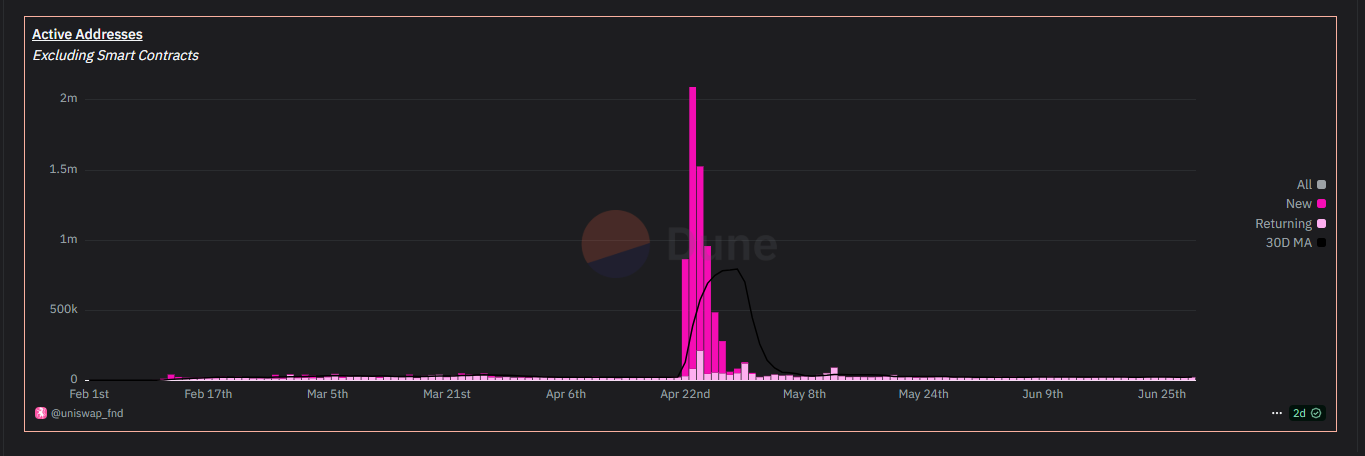
Meanwhile, Base - the Layer 2 network operated by Coinbase is demonstrating a clear lead across nearly every growth metric.
Base consistently maintains between 1.6 to 2 million daily active users, attracts over 100,000 new users per day, supports an ecosystem of more than 400 active projects, and generates net annual profits of up to $125 million - equivalent to approximately $130,000 in weekly profit from transaction fees alone.
Notably, Base not only leads in terms of user scale, but has also established a sustainable profit model, thanks to its tight integration with Coinbase’s centralized (CeFi) ecosystem and its ability to convert centralized users into on-chain participants.


In contrast, Unichain is currently generating only around 2–3 ETH in daily revenue, equivalent to approximately $10,000 USD - a figure that pales in comparison to Base or other top-tier Layer 2s such as Arbitrum and Optimism.
This directly results in extremely limited revenue sharing for both $UNI stakers and Unichain validators, falling far short of creating a compelling value stream for investors who believed in Uniswap’s revenue-sharing model.
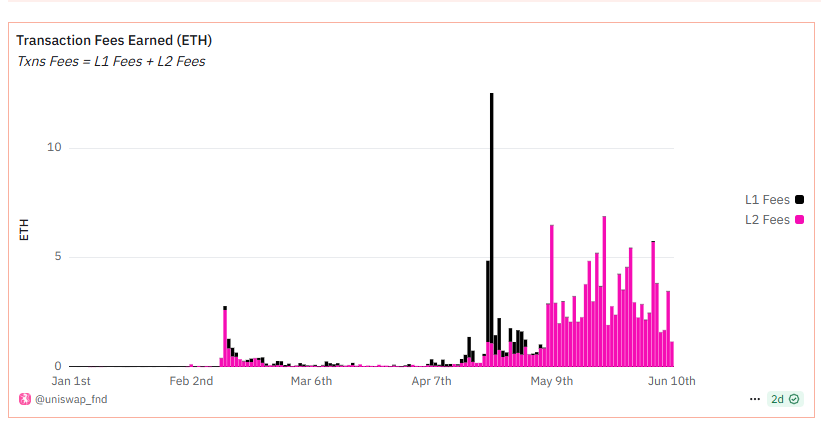
What’s particularly noteworthy is that the gap between Unichain and its competitors is not limited to financial metrics - it also highlights a fundamental difference in growth strategy.
This reality poses a critical question for investors:
Is Unichain’s vision to become the central infrastructure layer for DeFi compelling and agile enough to stay in the race, especially as Base continues to capture market share through a mass adoption strategy, effectively bridging CeFi and DeFi?
Without decisive changes in product development, user experience, and builder engagement strategies, Unichain risks becoming a peripheral Layer 2 - merely supporting the Uniswap ecosystem, rather than evolving into a true DeFi liquidity hub as originally envisioned.
That said, it’s also important to recognize that despite user acquisition and revenue challenges, Unichain has achieved notable success in building liquidity infrastructure.
In under five months since mainnet launch, Unichain has surpassed $800 million in TVL, with more than 50% of that coming from stablecoins. This indicates that the network is gradually becoming a reliable liquidity center for DeFi protocols - especially for applications focused on stablecoins and low-risk yield strategies.
This is a positive signal of growing institutional trust and confidence from major DeFi protocols and liquidity providers, even if retail user adoption has yet to reach initial expectations.

Uniswap v4 – The Upgrade That Could Propel Uniswap to Its Next Growth Phase
Since its release in May 2021, Uniswap v3 marked a major turning point in the DeFi space with the introduction of “concentrated liquidity” - a mechanism that allows liquidity providers (LPs) to allocate capital within specific price ranges, rather than across the entire price curve as in previous versions.
This innovation significantly improved capital efficiency and has helped Uniswap v3 maintain its position as the market leader for nearly four years.
In fact, according to Dune Analytics, Uniswap currently processes around $3.3 billion in daily trading volume, accounting for 23% of global DEX market share, placing it at the top of the decentralized exchange landscape.
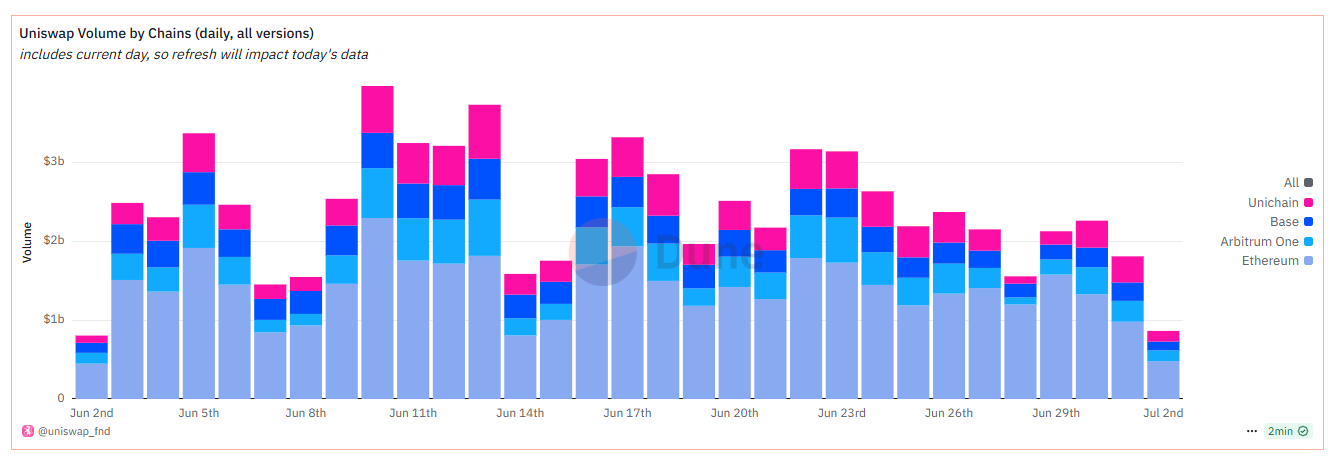
This figure is further confirmed by DeFiLlama, which reports a similar volume of approximately $3 billion per day, with Uniswap firmly holding the #1 spot, far ahead of its closest competitor PancakeSwap, which handles $2.7 billion in daily volume and holds a 21% market share.
However, despite its dominance in trading volume, Uniswap’s Total Value Locked (TVL) currently hovers around $5 billion - less than half of its 2021 peak. This reflects a broader trend across the DeFi space, where overall TVL remains subdued compared to its all-time highs, with industry-wide estimates ranging between $124 billion and $132 billion.
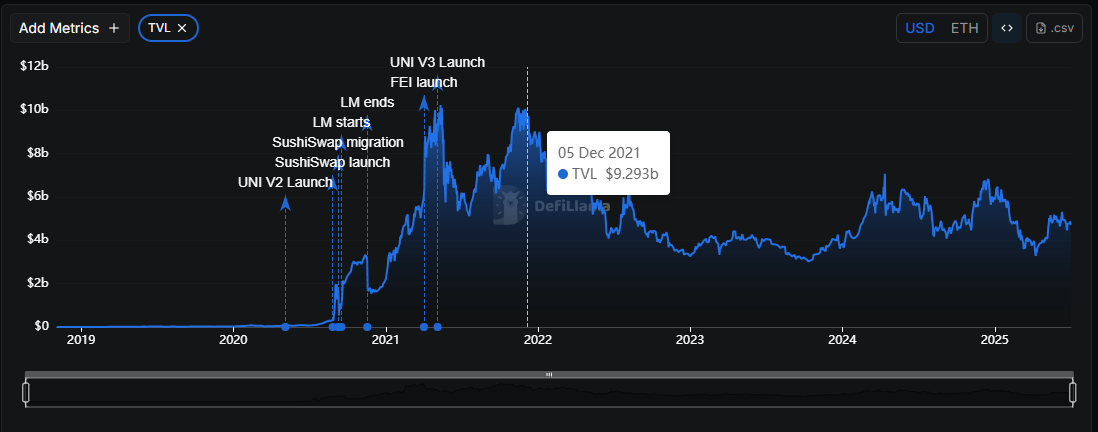
Against this backdrop, Uniswap v4, officially announced in January 2025, is expected to be a game-changing upgrade - not only building on the success of v3 but also enabling Uniswap to adapt more rapidly to market shifts and meet the increasing demands of both users and developers.
The most significant highlight of v4 lies in its infrastructure scalability and customizability, with the ambition to evolve Uniswap beyond a simple AMM into a comprehensive liquidity infrastructure platform or what could be described as a “DeFi Liquidity Operating System.”
At the core of Uniswap v4 is the Hooks mechanism, a feature that allows developers to embed custom code at specific points in a pool’s lifecycle, including during initialization, when liquidity is added or removed by LPs, and before or after each swap.
Hooks effectively transform every liquidity pool into a highly programmable module, enabling the creation of advanced functionalities such as dynamic fee structures, limit orders, TWAP (time-weighted average price) orders, or even the reuse of out-of-range liquidity in other protocols like lending platforms, opening up new avenues for yield generation.
This marks a significant leap forward compared to the rigid pool model of previous versions.
According to data collected more than six months after launch, over 1,600 unique Hooks have already been deployed on Uniswap v4, with total accumulated trading fees across all chains reaching nearly $30 million USD.


In addition to Hooks, Uniswap v4 introduces a major infrastructural change known as “The Singleton.”
In previous versions of Uniswap, each trading pair required the deployment of a separate smart contract. With Singleton, however, all liquidity pools are consolidated into a single smart contract.
This architectural shift not only optimizes gas costs, particularly for complex multi-step transactions, but also reduces the cost of deploying new pools by up to 99%, enabling builders to create new trading pairs at virtually zero cost.
Singleton also integrates a “flash accounting” system, which allows only the net balance difference to be transferred after a transaction is completed, rather than moving the full asset amounts throughout the swap process as is the case with Uniswap v3.
This contributes to significantly lower gas fees for end users, enhancing the economic efficiency of the protocol. Open Question: Can v4 Truly Become the Next Growth Catalyst for Uniswap?
Yet, a key question remains: Will Uniswap v4 truly deliver on its promise to become the next major growth driver for the Uniswap ecosystem, as v3 did in 2021? And more importantly, will it generate real value for investors who believe in the $UNI token?
When examining real-world performance metrics, six months post-launch, Uniswap v4 currently records only around 35–50% of the daily trading volume of Uniswap v3, suggesting that market adoption is still relatively limited.

In terms of liquidity, although Uniswap v4’s TVL recently surpassed the $1 billion mark for the first time equivalent to approximately 20% of Uniswap’s total TVL, this figure remains relatively modest compared to Uniswap v3, which currently maintains around $2.3 billion in TVL, accounting for nearly 48% of the total.

In terms of liquidity, although Uniswap v4’s TVL recently surpassed the $1 billion mark for the first time - equivalent to approximately 20% of Uniswap’s total TVL this figure remains relatively modest compared to Uniswap v3, which currently maintains around $2.3 billion in TVL, accounting for nearly 48% of the total.
Beyond market-related factors, several barriers have hindered Uniswap v4’s breakout growth. One of the key concerns involves smart contract risks associated with Hooks. Since Hooks allow custom code injection, they introduce potential vulnerabilities such as bugs or exploits, especially if not thoroughly audited.
From a builder’s perspective, accessing existing liquidity also presents challenges, as v4 and v3 operate on separate infrastructures and do not share liquidity directly. Moreover, in a market that has yet to experience a strong recovery, many investors and LPs are adjusting their capital strategies, which also contributes to the slower-than-expected growth of v4.
Nevertheless, Uniswap v4 introduces a structural opportunity for $UNI holders and stakers to benefit directly, by expanding Uniswap’s core business model.
Up until now, Uniswap’s primary revenue source has been the swap fees collected from trading pools. However, by default, these fees go entirely to liquidity providers (LPs), not to the protocol or token holders.
A proposal to redirect a portion of this revenue to the Uniswap treasury or $UNI stakers has been under discussion since 2023, but has not yet been officially implemented.
With Uniswap v4, the protocol’s revenue model has the potential to expand through three new growth drivers:
- Hooks-as-a-Service: Hooks are not just technical tools—they can also be monetized. For example, Uniswap Labs or third parties could develop premium Hooks (such as TWAP engines, boosted yield modules, or dynamic fee structures) and charge licensing or usage fees. If this model becomes standardized, it could unlock an entirely new revenue stream that is not dependent on traditional swap fees.
- Reduced Operating Costs for LPs, Driving Liquidity Growth: Singleton and Flash Accounting can reduce gas fees by up to 99% for new pool creation and 15–20% for average swaps, making it significantly cheaper for new liquidity providers to participate. Higher TVL leads to tighter spreads, which in turn boosts overall trading volume, indirectly increasing revenue from swap fees.
- Fee Switch Mechanism: The long-discussed Fee Switch (revenue-sharing from swap fees with the protocol or stakers) is likely to be activated alongside the adoption of v4. Thanks to Hooks and Singleton, which improve flexibility and cost-efficiency, resistance from LPs - previously a barrier during v3 discussions - will likely be much lower.
If the Fee Switch is activated at a 10–20% rate, and based on the current average daily trading volume of $3.3 billion, Uniswap could collect between $3M and $6M in monthly trading fees (equivalent to $36M–$72M annually) from v3 and v4 alone.
If v4 continues to grow and surpasses v3, this figure could double.
Following a distribution model similar to other Layer 2s (e.g., Base allocates 65% to stakers, 35% to treasury), $UNI stakers could realistically expect to earn between $23M and $47M per year excluding additional revenue from Hooks or other monetization models.
The potential APY for $UNI stakers would range from 5% to 10%, depending on lock-up durations and the total amount of UNI staked (estimated to be 30–50% of the circulating supply).
If key performance metrics including trading volume, TVL, user growth, and especially the adoption rate of Hooks on Uniswap v4 continue their upward trend or accelerate in the coming months, this could mark a strategic transformation for the $UNI token.
Specifically, $UNI may no longer be just a governance token, where utility is limited to DAO voting rights, but could evolve into a true cash-flow token - delivering real, recurring revenue to long-term holders.
UniswapX and the Rise of Intent-Based Trading
Why is intent-based trading gaining so much attention?
Imagine you’re a DeFi trader looking to swap token A for token B. But liquidity is fragmented across multiple chains and protocols, forcing you to manually find the best execution path, pay gas fees, and deal with the risk of front-running.
That’s the reality many DeFi users have experienced.
Intent-based trading has emerged as a solution. Instead of executing a trade directly, you simply sign an "intent". For example, "I want to swap 100 USDC for ETH at the best possible rate" and the system will automatically figure out the optimal way to fulfill it.
Research suggests this trend has gained traction due to several key factors:
- Liquidity fragmentation: As more Layer 2s and AMMs emerge, liquidity is becoming increasingly siloed, making price discovery and execution more complex.
- Gas costs: UniswapX eliminates gas fees for users, shifting the cost to fillers (executors), thereby lowering financial barriers.
- MEV protection: By using private relays and off-chain execution, intent-based trading reduces the risk of front-running and sandwich attacks.
- User experience: The process is dramatically simplified, making DeFi more accessible - closer to the experience of trading on centralized exchanges (CEXs).
This shift isn't just about technology, it’s about responding to rising user expectations in the DeFi space. Protocols like CowSwap and 1inch Fusion have already pioneered this model, pushing Uniswap to take action or risk falling behind.
In July 2023, Uniswap Labs entered the arena with the official launch of UniswapX, an entirely new trading architecture designed to position Uniswap as a key player in the “intent revolution.”
With UniswapX, users no longer have to worry about gas fees or finding the best execution route. Instead, they simply sign an off-chain intent, and a network of solvers (trade executors) competes to fulfill the trade at the best possible rate - sourcing liquidity from any venue (DEXs, CEXs, aggregators, etc.).
The best-performing solver wins the bid to execute the trade and earns a reward.
Key Features of UniswapX v1
- No gas fees for users – solvers cover the transaction cost.
- Reduced MEV risk – orders are matched off-chain before being executed on-chain.
- Better pricing – due to competition among solvers.
- Seamless, user-friendly experience – bringing DeFi closer to the simplicity of Web2.
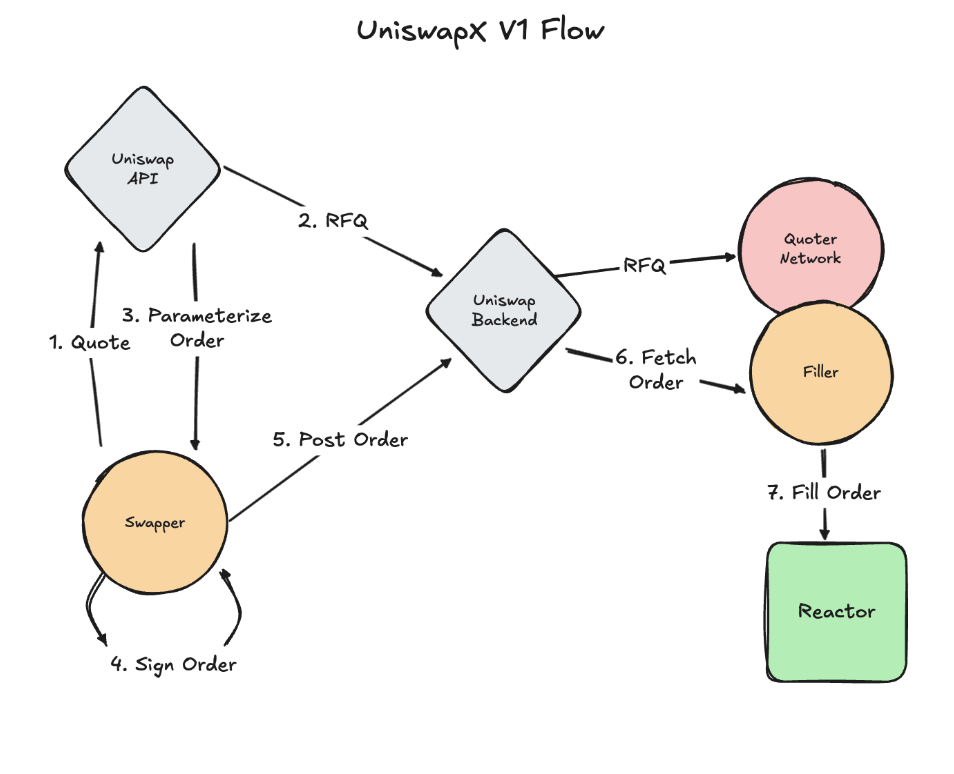
Just over a year later, UniswapX received its first major upgrade: UniswapX v2, designed to be fully compatible with and leverage the power of Uniswap v4 and its Hooks architecture.
If v1 was the initial step toward enabling intent-based swaps, then v2 represents the evolution of those ideas into a comprehensive infrastructure layer.
Key Highlights of UniswapX v2
- Deep Integration with Hooks: Traders can customize transaction logic via Hooks for example, implementing KYC checks, volume limits, MEV reduction mechanisms, and more, all within the swap process itself.
- RFQ Pools (Request-for-Quote Pools): Market makers (LPs) can now participate in auction-style pools, where they provide real-time quotes and compete directly to fill user intents. This creates a much more efficient liquidity market compared to traditional AMMs.
- Cross-Chain Intents: UniswapX v2 is no longer limited to Ethereum. It’s designed to expand across multiple chains using bridge solutions like Chainlink CCIP, LayerZero, or Wormhole. Users can seamlessly swap a token on Chain A for a token on Chain B with no complex interactions required.
- Smart Gas Fee Auctions: Solvers can flexibly bid on gas fees, meaning users not only avoid paying gas themselves, but may even receive a partial rebate from the solver if the market is competitive enough.
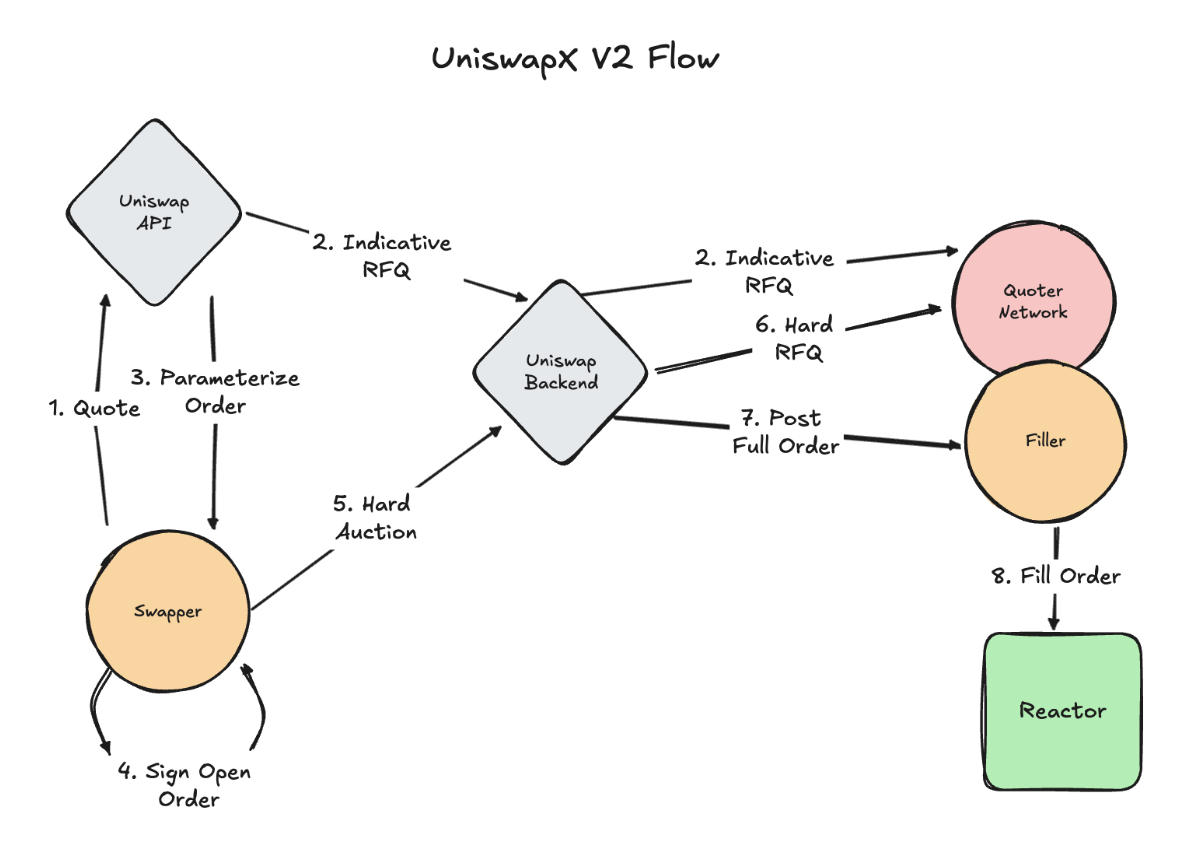
The transformation of Uniswap through UniswapX v2 is not merely a technical upgrade.
Uniswap is no longer just a decentralized exchange based on an AMM formula. It is gradually evolving into an “intents engine” infrastructure layer for the entire DeFi ecosystem.
In this new paradigm:
- Users only need to express what they want.
- The infrastructure figures out the best way to achieve it.
- Solvers, LPs, CEXs, and DEXs become “workers” competing to fulfill user intents.
Where does UniswapX stand in this race?
Since its official launch, UniswapX has surpassed $22 billion in total trading volume, generating approximately $66 million in trading fees (based on the standard 0.3% fee per transaction executed via UniswapX).

However, UniswapX is still struggling to compete for market share in the DEX aggregator space, especially against CoWswap, Fusion (1inch), and Paraswap. Currently, UniswapX holds only 4.7% of the market, while CoWswap dominates with 79%, followed by 1inch Fusion with 15%.
Although UniswapX only holds around 4.7% of the intents market share, the $22 billion in trading volume carries significant meaning:
- First, it proves that real usage momentum for UniswapX exists, especially given that the Uniswap ecosystem remains the most accessed platform in DeFi.
- Second, this volume lays a critical foundation for activating the $UNI fee switch in the future, should governance proposals be approved.
- Third, a large portion of UniswapX’s volume comes from its native integration into the Uniswap interface, which indicates that—with the right push (e.g., incentives, UI prioritization, solver rewards) - UniswapX's market share could grow rapidly.UniswapX v2 is expected to be Uniswap’s strategic answer to rising competitive pressure
- Hooks unlock a level of customizability that CoWswap and 1inch Fusion struggle to replicate, as they do not control a native AMM.RFQ Pools will attract professional LPs, enabling UniswapX to compete on pricing and large volumes.
- Cross-chain intents could become a strategic weapon, especially if UniswapX expands to support the popular Layer 2 chains.
While UniswapX currently holds a modest position in the intent-based trading leaderboard, it is far from being out of the game.
On the contrary, with over $22 billion in volume generated within just one year, UniswapX demonstrates that with the right infrastructure (v4 + Hooks) and the right expansion strategy (RFQ + cross-chain), it can transition from a late mover to a category leader.
- CoWswap dominates with first-mover advantage and powerful middleware.
- 1inch Fusion benefits from a strong RFQ engine and a large user base.
- But UniswapX has something no other competitor has: the #1 native AMM, and a groundbreaking infrastructure toolkit (Hooks) unmatched in DeFi.
Uniswap is rebuilding its entire value structure – and $UNI is at the center
As DeFi rapidly evolves around three major trends: fragmented liquidity, intent-based trading, and modular blockchains. Uniswap is not merely keeping up, but redefining itself from an AMM into a full-stack liquidity infrastructure ecosystem.
From Unichain (its dedicated Layer 2), to Uniswap v4 (featuring Singleton and Hooks), and UniswapX (the intent-based engine), these are no longer standalone products.
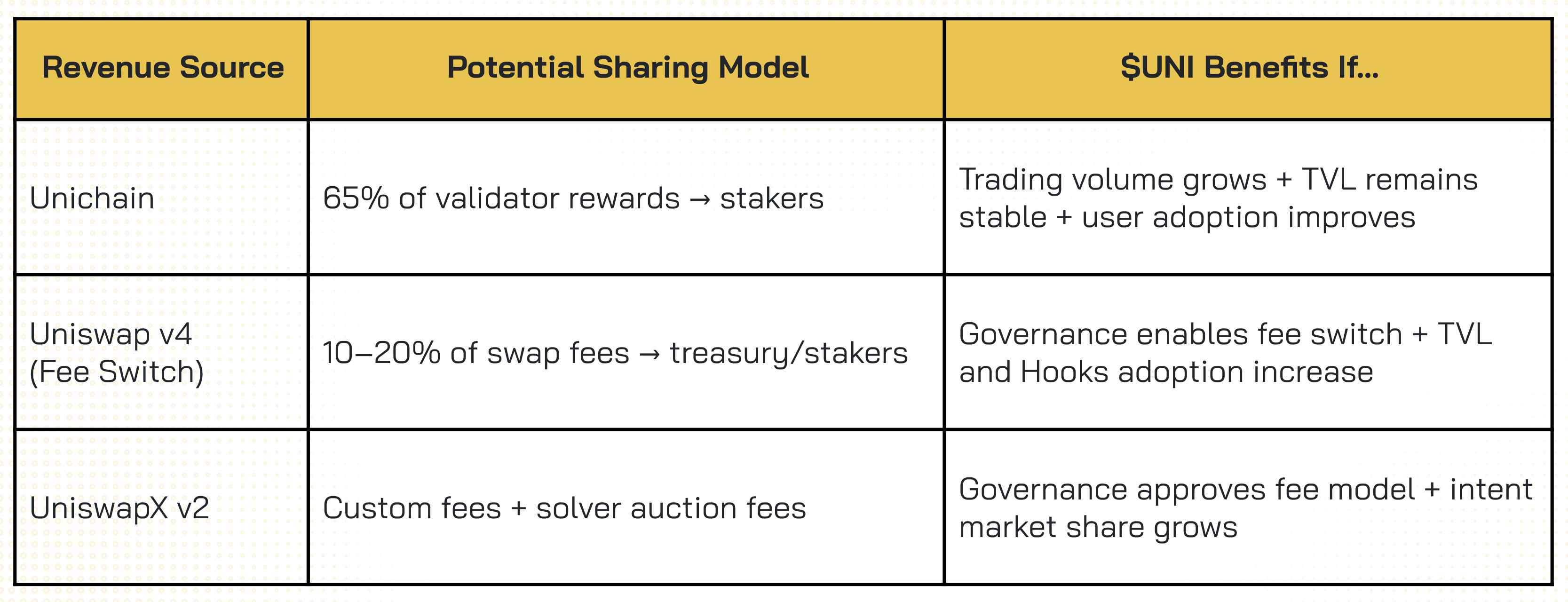
Over its more than four-year existence, $UNI has long been a symbol of the governance token model—a token that granted investors voting rights, yet offered virtually no real cash flow from the ecosystem they helped build.
However, the 2024–2025 period marks a historic turning point for Uniswap—not only in terms of product direction, but more importantly, in how value is distributed to those who believe in the protocol’s long-term vision.
Most importantly, all of these new models introduce revenue mechanisms that can be directly allocated to $UNI stakers, representing a clear evolution from a “governance token” to a “cash-flow-generating token.”